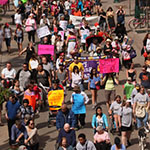Canada Disability Benefit and “a number” – some basics
By: Michelle Hewitt
What’s the poverty line in Canada?
That may seem like a simple question with a simple answer, but it just isn’t. Poverty isn’t simple, so the answer to the question is complex.
In 2015, Canada decided to use the Market Basket Measure to calculate its poverty line – and it rebranded it “Canada’s Official Poverty Line”. It measures 5 components – clothing, food, shelter, transportation and “other” – to create a “basket” of goods and services Canadians need to buy, and creates an amount that it costs to purchase them.
For example, it details how many of various types of clothes you should have a year (one pair of blue jeans for each of us!). If you are interested in what’s in the basket, take a look at the appendices from page 26 onwards in this document:
https://www150.statcan.gc.ca/n1/en/pub/75f0002m/75f0002m2020002-eng.pdf?st=SazI6WIy
None of the items in any of the components take disability into account.
Furthermore, we know that living in different places costs different amounts of money, particularly when it comes to shelter. So, Canada doesn’t have one poverty line. It currently has 52 and it isn’t done – it hasn’t completed this process for the territories yet. The 52 different amounts can be found on page 8 of that same document. It gives the amounts for a family of 4 – 2 adults and 2 children – in 52 different types of community, from province to province, from the smallest rural communities to big urban centres.
At Disability Without Poverty, one of our key principles is that a Canada Disability Benefit (CDB) should be an individualized benefit, not means tested as a family, so that disabled people have their own independent funds. There is a simple calculation that is applied to that table for individuals – you divide the sum in half.
The lowest amount for an individual calculating from that table, is for someone in Quebec, living in a community of between 30k and 100k people. The poverty line for them in 2018 was $18,771 a year, which is $1,564 a month.
The highest amount for an individual calculating from that table, is someone in Vancouver. The poverty line for them in 2018 was $24, 229 a year, which is $2,028.
Of course, then the pandemic came along. The federal government said that $2,000 was a “living wage”, so now everyone thinks the “poverty line” is $2,000. It isn’t.
A fresher – how much money do people on various disability benefits get?
There are two main government assistance payments that people with disabilities may access, as well as a number of private insurances.
Federally, for some people, the income is from CPP-D – Canada Pension Plan, Disability. This is only available if you have worked and paid CPP contributions. The average payment is $1031 while the maximum is $1,413.
For those who get disability assistance from their province or territory, the monthly rates are
| New Brunswick | $705 |
| Newfoundland and Labrador | $754 |
| Nova Scotia | $850 |
| Nunavut | $944 |
| Prince Edward Island | $987 |
| Saskatchewan | $1064 |
| Manitoba | $1068 |
| Quebec | $1111 |
| Ontario | $1169 |
| British Columbia | $1358 |
| Yukon | $1654 |
| Alberta | $1684 |
| Northwest Territories | $2153 |
So, if you live in Fredericton, New Brunswick, Canada’s Official Poverty Line is $1829, not taking your disability into account, but the province gives you $705 a month. I’m sure there’s more to this – I haven’t looked at what the province pays for outside of this – but the hard figures are a difference of over $1100 a month.
How much does it cost to be disabled?
There’s certainly no easy answers to this question either. The answer to this is – we don’t know, because Canada doesn’t measure it. Andre Picard, Globe and Mail columnist, recently paraphrased a well-known quote by William Bruce Cameron, a sociologist, to say “If you don’t count it, it doesn’t count!” (If you’re interested, the original quote is “not everything that can be counted counts, and not everything that counts can be counted”). We have failed to “count”disabled people in many ways on many things for many years. So, it will be of no surprise to you to know that Canada has no data on how much it costs to be disabled – or at least none that we can find.
Over the summer, we commissioned a PhD student, Alexandra Creighton, to research this question, and provide us with some notes on the best research she could find on what we have been calling “the disability poverty line”. She found very little. However, she did find a number of articles – and again, not that many – that discussed the cost of being disabled.
There is one article by Zaidi and Burchardt in 2005 that was used as the standard by others in discussing this issue. It is from the UK, which is fairly comparable with Canada because both countries have a publicly funded health system, amongst other similarities in its welfare structure. It could be that for each point on a severity scale of disability, the “cost of living” or whatever we might want to call it, was 4.5% higher.
Someone with a low level of disability, 3 points, has costs that are 13.5% higher.
Someone with a medium level of disability, 9 points, has costs that are 40.5% higher.
Someone with a high level of disability, 17 points, has costs that are 76.5% higher.
For our purposes, the chances of someone with a low level of disability being eligible for any of our provincial, territorial, federal or private assistances programs are small. The people we are looking at helping have costs that are 41% to 77% higher than those with no disability, according to this research.
In 2020, Zaidi wrote another article, this time with Smith, and did a survey of other research into the same topic. Alongside, Zaidi’s original piece, the estimates most relevant to us that they found are:
Research from Ireland that said the extra cost estimates are 44% for severely disabled people.
Research from Australia that said extra cost estimates are 37% for the average of all disabled people, but 49% for the most severely disabled people.
More research from the UK that said extra cost estimates are 62% for the average of all disabled people.
What does this mean for us?
We have to use the same economic tools the government uses. They have established how poverty is calculated in Canada, so it is far beyond our remit to challenge that.
However, I believe we can challenge how benefits are calculated, and how this works for disabled people. It simply makes no sense to me to just add some dollars here and there, with the same amount going to the whole country, but the costs being different.
My ask?
We ask that all eligible disabled Canadians receive a benefit package that is 40% above Canada’s Official Poverty Line, based on the community they live in. Furthermore, the most severely disabled Canadians receive an additional 25%, based on proof of this severe disability.
And, this will only bring these disabled Canadians to the poverty line. No rainbows and lollipops. Just the dignity of affording the basics in life.

Michelle Hewitt is a co-chair of Disability without Poverty and is dedicated to maximizing her time to find ways to bring people with disabilities out of poverty.



